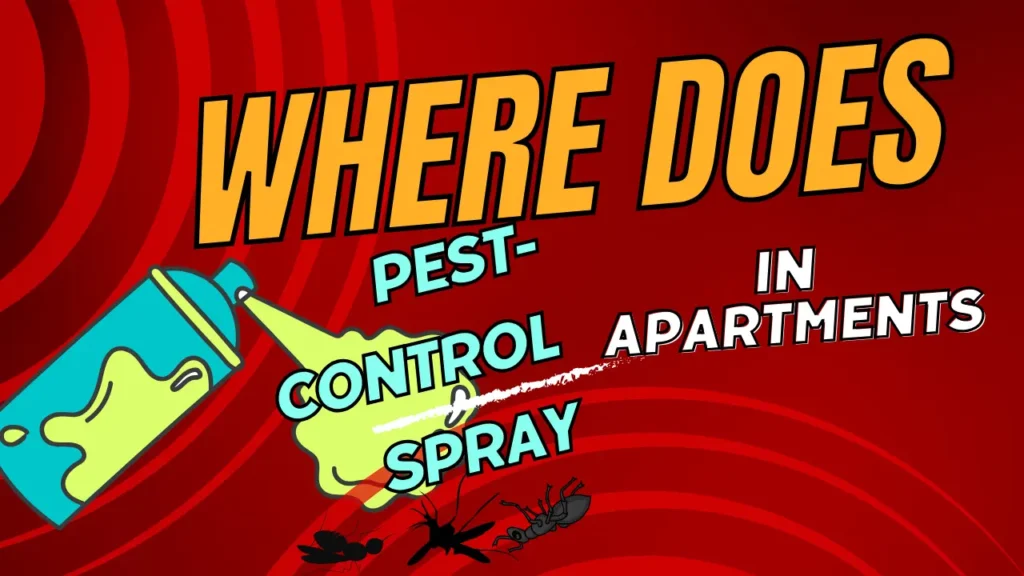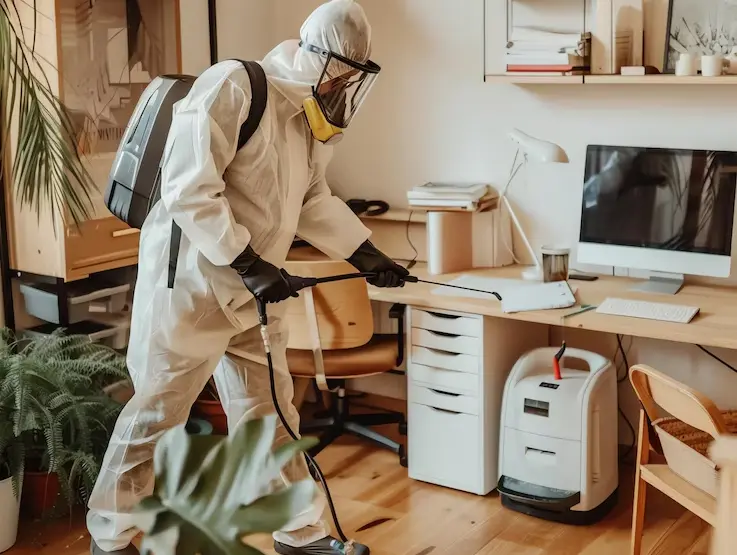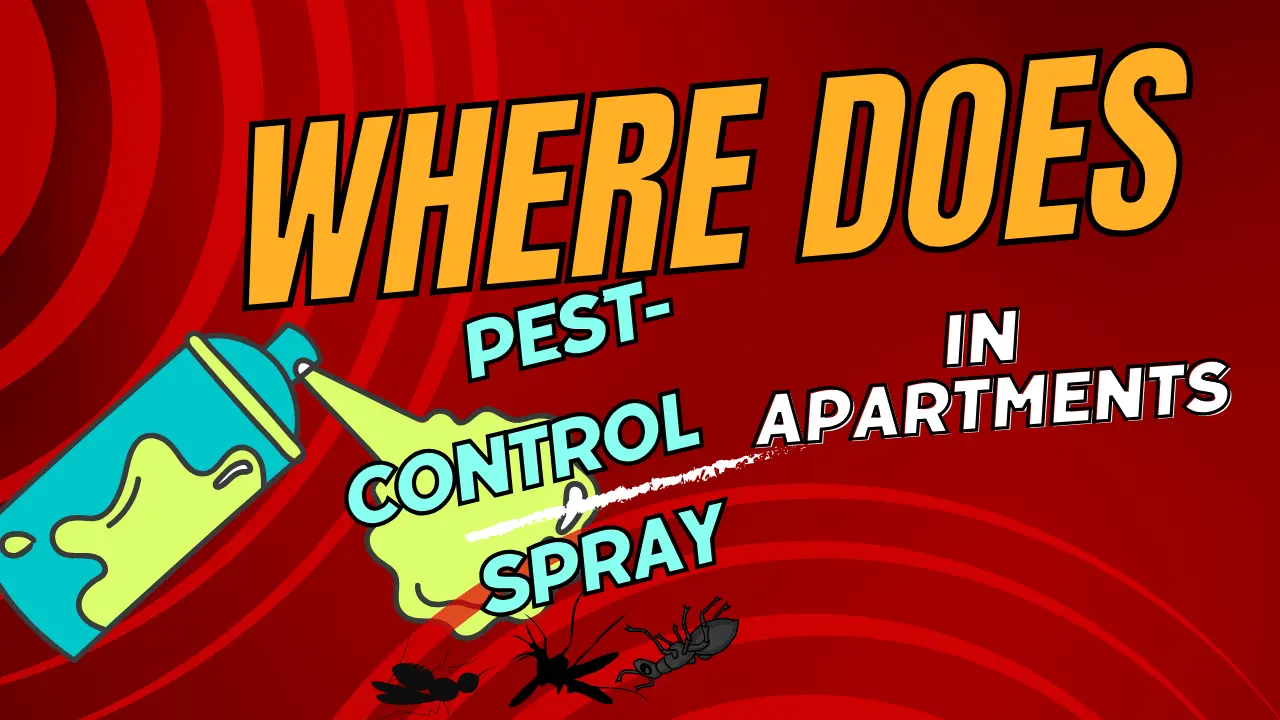Where Does Pest Control Spray in Apartments
When living in an apartment, pest control is essential to maintaining a healthy and comfortable living environment.
Unlike single-family homes, apartments present unique challenges due to the close proximity of multiple units.
Where Does Pest Control Spray in Apartments
Below, you’ll find where pest control treatments are typically applied in apartments and what you can expect during a treatment.

Common Pest Control Spray Areas in Apartments
1. Kitchens and Food Preparation Areas
The kitchen is a hotbed for pests due to the availability of food and moisture. Pest control professionals focus on the following areas:
- Under and behind appliances – Cracks and crevices around refrigerators, stoves, and dishwashers are common entry points for pests.
- Pantry cabinets and shelves – Shelving and cabinets store food, making them attractive to pests such as ants and roaches.
- Sink and drain areas – Damp environments near sinks and drains can harbor pests such as silverfish and drain flies.
Read More: Signs You Need Pest Control In Your Home Immediately
2. Bathrooms and damp areas
Bathrooms provide the necessary moisture and water sources that pests need to thrive. Key places to spray include:
- Baseboards and corners – These areas are prone to moisture buildup, which attracts pests such as silverfish.
- Shower Curtains and Bathtubs: Pests can hide in folds and cracks, making thorough spraying essential.
- Toilets and Drains: Effective spraying around toilets and drains helps prevent drain fly and cockroach infestations.
3. Living Rooms and Common Areas
High-traffic areas can unintentionally offer hiding places and food sources for pests. Focus areas include:
- Carpets and Rugs: Pests such as carpet beetles and spiders can nest in fibers, requiring targeted spraying.
- Furniture Crevices: Upholstered furniture can harbor pests, making thorough spraying necessary.
- Electrical Outlets and Switches: Small openings can serve as entry points for pests such as termites and ants.
4. Bedrooms and Personal Spaces
Ensuring bedrooms are pest-free is essential for a peaceful environment. Areas to spray include:
- Bed frames and headboards – Pests like bed bugs can hide in the seams and joints of furniture.
- Closets and storage areas – Dark, enclosed spaces are ideal for pests like moths and spiders.
- Windowsills and door frames – These areas are entry points for flying insects and other pests.
5. Laundry rooms and storage areas
Laundry rooms often house appliances and stored items that can attract pests. Key places to spray include:
- Washer and dryer units – Moisture from clothing can attract pests like silverfish and cockroaches.
- Shelves and storage boxes – Stored items can provide food and shelter for pests, necessitating thorough spraying.
- HVAC systems and vents – These systems can distribute pests throughout the apartment, making targeted spraying crucial.
Choosing the Right Pest Control Services
Selecting a reputable pest control service is vital for effective treatment. Consider the following factors:
Experience and expertise
- Specialized knowledge – Make sure the service has experience treating the specific pests prevalent in apartments.
- Licensed professionals – Check that technicians are certified and trained in pest control methods.
Eco-friendly solutions
- Safe pesticides – Opt for services that use nontoxic and environmentally friendly pesticides.
- Sustainable practices – Choose companies that implement IPM strategies to minimize ecological impact.
Customer reviews and testimonials
- Positive feedback – Look for services with high ratings and positive customer testimonials.
- Transparent practices – Services that provide clear information about their methods and products are preferable.
Comprehensive service offerings
- Full-service treatments – Services that offer inspection, treatment, and follow-up ensure thorough pest control.
- Customized Plans: Customized pest control plans address the unique needs of each apartment.
Integrated Pest Management (IPM) Strategies
Effective pest control in apartments goes beyond fumigation. Integrated Pest Management (IPM) combines multiple strategies to ensure long-term pest prevention and control.
Inspection and Identification
Regular inspections help identify pest entry points and infestation levels. Knowing the specific pest species guides the selection of appropriate treatment methods.
Preventive Measures
Remember that closing gaps, cracks, and holes prevents pests from entering the apartment.
That’s why maintaining cleanliness reduces water and food sources that attract pests. Safely storing and disposing of trash minimizes pest attraction.
Targeted Treatments
Safe and effective pesticides are applied to high-risk areas. Methods such as traps and barriers complement chemical treatments for comprehensive pest management.
Monitoring and Follow-Up
Consistent inspections ensure that pest control measures remain effective. Periodic treatments address any new or persistent pest problems.

Tenant and Landlord Responsibilities
In most cases, landlords are responsible for arranging and paying for pest control services to maintain a habitable environment.
However, tenants also play a role in preventing infestations by keeping their apartments clean and reporting any pest problems promptly.
Conclusion
Understanding where to apply pest control sprays in apartments can help tenants prepare for treatments and maintain a pest-free living space.
By working together, tenants and landlords can ensure that pest control measures are effective and that the apartment remains a comfortable place to live.
People Also Ask (Q&A)
How do I prepare my apartment for pest control spray?
Preparing for pest control involves several steps to ensure that treatment is effective and safe:
Declutter – Remove unnecessary items and organize your space to allow easy access to all areas.
Clean thoroughly – Clean your home, especially kitchens and bathrooms, to remove food particles and other attractants.
Store food and utensils – Place all food in sealed containers and cover or put away utensils and cookware.
Move furniture – Move furniture away from walls so technicians can access baseboards and corners.
Cover items – Cover or put away personal items, toys, and pet belongings.
Vac the area – Plan to be out of your home for the recommended amount of time after treatment, usually 2 to 4 hours.
When pest control spray is applied, where are they sprayed?
Pest control professionals often spray in areas where pests are likely to hide or travel, including:
✅Baseboards and walls
✅Doorways and thresholds
✅Cracks and crevices
✅Gaps between walls and cabinets, appliances, or furniture.
Is Pest control sprayed in cabinets?
Yes, pest control professionals often spray inside cabinets, especially in kitchens, to target pests such as cockroaches that hide in these areas. It is important to remove or cover food and utensils before treatment.
Is pest control sprayed in closets?
Yes, pest control sprays can be used in closets to control and eliminate pests such as moths, silverfish, and other insects that can damage your clothing or other stored items.
Do exterminators spray inside the home?
Yes, exterminators spray inside the home, particularly when there is an active infestation or as a preventative measure in high-risk areas. They follow strict guidelines to ensure safety and effectiveness.
Can I sleep in my home after pest control?
You can usually return home a few hours after treatment, but it’s best to follow the specific advice of your pest control provider. Depending on the chemicals used, they may recommend you stay outside for 2 to 4 hours or up to 24 hours.

